Edwin Stanton Porter Part VI:
Life of an American Fireman & its Antecedants
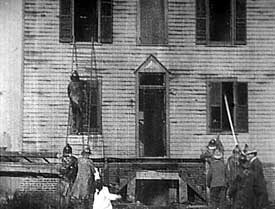 Among the earliest "story films" (but by no means the first as often alleged) was Edwin S. Porter's Life of an American Fireman (1903) filmed in 1902 & released January of '93.
Among the earliest "story films" (but by no means the first as often alleged) was Edwin S. Porter's Life of an American Fireman (1903) filmed in 1902 & released January of '93.
It is six minutes long, with sequential scenes amounting to jump-cut editing advanced for the time. Porter had assistance from stage director George S. Fleming.
It may have been the first film to convey a character's thoughts. The opening scene shows our heroic fireman seated, eyes closed, in reverie. To the right of the screen we see his thoughts manifested, warm feelings toward his wife & daughter.
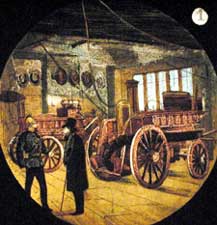 Both real & faked or "reproduced" footage about firefighters had already become de rigour in the kinetoscopic era. Both real & faked or "reproduced" footage about firefighters had already become de rigour in the kinetoscopic era.
Even Porter had already made the three-minute Burning of Durland's Riding Academy (1902), mainly documenting the fight against the blaze & the clean-up after.
The Durland fire occurred on Manhattan's west side, but was later retitled Firemen Fighting the Flames at Paterson only because it was a more famous fire.
The footage is startling & good, & must've convinced Porter he had to do something more elaborate with the theme of firefighting, something beyond primitive newsreel.
The theme had even been popular in the magic lantern era with a set of twelve projected images known as Bob the Fireman popular in the late 1880s & still in circulation in the 1900s with many families still keeping magic lanterns for home use. (One of these hand-painted magic lanter discs is shown at the top of the page, another near this paragraph.)
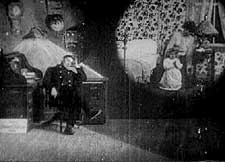 But it was not until Life of an American Fireman that there existed a fictionalized biopic. It was still in the main a documentary (perhaps docudrama would better describe it) about the heroic workings of the fire department, but by presenting a protagonist with his own point of view it came close to a work of fiction.
But it was not until Life of an American Fireman that there existed a fictionalized biopic. It was still in the main a documentary (perhaps docudrama would better describe it) about the heroic workings of the fire department, but by presenting a protagonist with his own point of view it came close to a work of fiction.
Cameraman James H. White was cast as in the leading role, but there is some question as to whether or not that's him in every scene, as Edison's general manager W. E. Gilmore was against turning Black Maria employees into film stars.
Gilmore requested reshoots wherever White was recognizable, which may or may not have been done in November 1902, while White was away from the studio getting married.
Other film historians doubt the retakes were made, as some of it would impose on the East Orange fire department which had lent a great deal of assistance to make the film realistic.
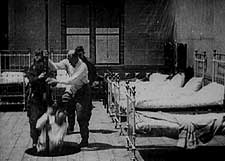 It would be hard to gather their assistance for retakes of any of the important scenes, like the heroic climax with James White on the ladder. The fire that was to be set for the filming had been much in the news as advance publicity, so it was already well known that the film was finished. It would be hard to gather their assistance for retakes of any of the important scenes, like the heroic climax with James White on the ladder. The fire that was to be set for the filming had been much in the news as advance publicity, so it was already well known that the film was finished.
The film recreates the moment when fireman are awoken by the fire alarm, slide down the pole to the garage, & race the horse-drawn engines through the lightly snowy streets.
For the race of the fire engines Porter was able to build on several films that previously showed exclusively this scene, notably "actuality films" by William Heise & James H. White like The Morning Alarm (1896) & Going to the Fire (1896) which have the same general presentation of the theme of speeding horses pulling the fire wagons.
The climax of Life of an American Fireman has the heroic fire fighters saving a woman & child from a burning building, then fighting the blaze with hose. Soon they discover there are two more lives to save in the upper floor, effectively achived.
Again Porter had previous films to assess & improve upon, notably Dickson & Heise's Fire Rescue Scene (1894).
The Dickson/Heise film has good smoke FX, real firemen costumes, the fireman on a ladder (a short ladder to keep it in the stationary frame), & a curly-haired girl lowered to safety followed by a boy seemingly dropped from above into the ladderman's arms. All parallelled in Porter's much more epic take on the subject matter.
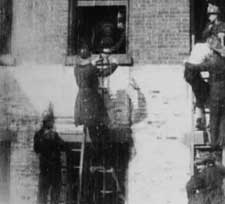 Similar is J. Stuart Blackton's Firemen Rescuing Men & Women (1899). Similar is J. Stuart Blackton's Firemen Rescuing Men & Women (1899).
The ladders against windows, smoke FX, & firemen helping individuals safely to the ground, is just a random moment, but it could easily have been spliced into Porter's film at the window-ladders sequence.
For action, excitement, & suspense, Life of an American Fireman rates awfully high, improving on all that went before, borrowing from what came before wherever it was already thrilling.
A theme that had already popular would positively explode in the public mind, & firefighting films would instantly increase in number, though none at the level Porter achieved in Life.
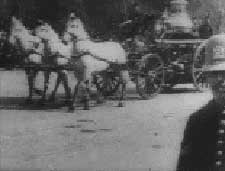 Porter followed up with a rather banal recording of a the Annual Parade, New York Fire Department (1904).
Porter followed up with a rather banal recording of a the Annual Parade, New York Fire Department (1904).
It hardly seemed to require Edison's best filmmaker, but he does overcome the reportorial blandness with some unexpected camera movement over close-ups of dignitaries, edit to deep focused moving shot with bowlered gentleman in foreground beyond whose head the whole length of street is visible.
It then cuts to the parade which is typical camera stationed to capture passing firemen on horses, fireman band, & the rest of the parade components one after the next. If you're a fireman fan you'll see some cool vintage equipment & dress uniforms, but nothing about recording a parade seriously advanced Porter's creativity.
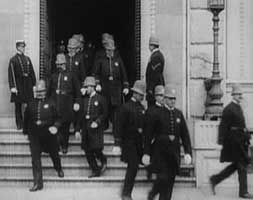 Attempting to duplicate the commercial success of Life of an American Fireman, Porter together with Wallace McCutcheon filmed Life of an American Policeman (1905).
Attempting to duplicate the commercial success of Life of an American Fireman, Porter together with Wallace McCutcheon filmed Life of an American Policeman (1905).
It was well promoted at the time, claiming all the events were true re-enactments, & it had a special opening consisting of two shows to benefit the Police Relief Fund.
It begins with a domestic scene with a police officer's wife & children, the toddler toddling about the room in a police helmet & carrying a truncheon. This lends one to expect a biopic about a single officer, which expectation will be disappointed.
Kissing the family goodbye, he's off to his job of protecting the public safety. Before long he encounters two street urchin little girls & buys them fruit. We don't see him doing anything of lasting benefit for them, but presumedly he did.
He or a similar police officer helps crowds safely across a busy street corner. And when a young woman attempts suicide by leaping off a pier, the police arrive in time to save her life.
Porter had made the film too long, a thousand feet being the maximum sought by exhibitors. So two versions were released, & the second version lacks the sequence of the attempted suicide, replacing it with a "River Tragedy" sequence.
The film unfortunately lacks the dramatic appeal of Life of an American Fireman. There's a long sequence of a horseback police chase to save a girl from her runaway horse, but only the final capture of the horse has any feeling to it.
Nor is there any narrative drive that might've occurred by implying these events reflected a day in the life of one policeman rather than several in unrelated incidents.
One long sequence involving the police stables I could barely figure out the point. In the context of "police are good," it seems odd to have one of the cops being a slacker hanging out with the stable manager, avoiding his duty. When nearly caught by the roundsman, he disguises himself as a civillian so as not to get in trouble.
No large event occurs to give it a sense of climax. Indeed it ends with two policeman killing time on horseback, one of them the groundsman over whom the slacker cop just pulled a fast one. The two mounted cops make their horses canter for a moment as the slacker cop rides by in his civies on a horse drawn buggy, & the show's over.
A scene that might've provided an actual climax was made as a separate shorter film, Desperate Encounter Between Burglar & Police (1905), a chase sequence based on a true incident of a brave officer who gave his life trying to capture a thief.
In a three-minute coda likewise sold as a separate film, Police Chasing Scorching Auto (1905), a police on horseback barely saves a little girl from being run down by a speeding auto. Then the cop on horse plus two bicycle cops take off after the speeding car.
The bulk of the film is a drawn-out slow chase scene, shown from behind, filmed from another vehicle. The driver finally pulls over near Grant's Tomb but nothing happens.
|
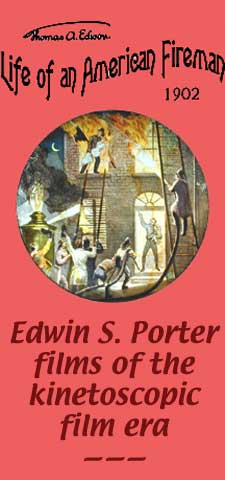

 Both real & faked or "reproduced" footage about firefighters had already become de rigour in the kinetoscopic era.
Both real & faked or "reproduced" footage about firefighters had already become de rigour in the kinetoscopic era.
 It would be hard to gather their assistance for retakes of any of the important scenes, like the heroic climax with James White on the ladder. The fire that was to be set for the filming had been much in the news as advance publicity, so it was already well known that the film was finished.
It would be hard to gather their assistance for retakes of any of the important scenes, like the heroic climax with James White on the ladder. The fire that was to be set for the filming had been much in the news as advance publicity, so it was already well known that the film was finished. Similar is J. Stuart Blackton's Firemen Rescuing Men & Women (1899).
Similar is J. Stuart Blackton's Firemen Rescuing Men & Women (1899).
